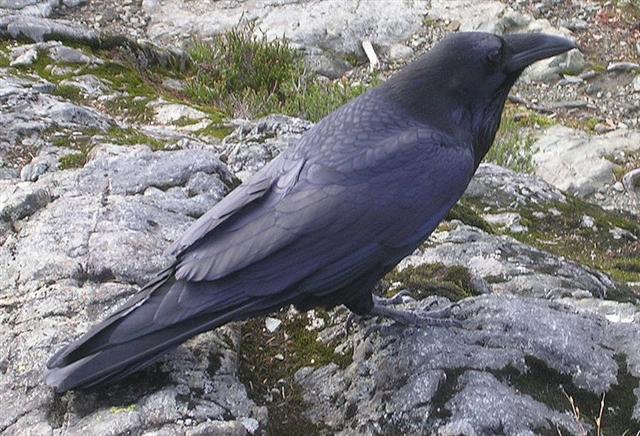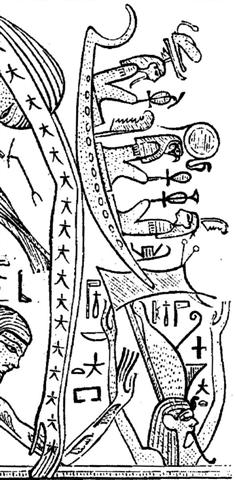The difference between 472 days (471 glyphs plus a vacant space) and 365 (for our year) is 107. Counting beyond December 31 (365) to day 472 means reaching April 17 (107). According to the star positions at the time of Julius Caesar 'April 17 would have been at ihe tau (the season, tau, of the spear, ihe) in Gb8-21, immediately before the Pleiades. At the time when Hyades II was at 0h this ihe tau would have been in day 70 (= 134 - 64 = 107 - 37), i.e. 12 * 29½ + 1 = 355 days after 0h - a position which resembles that of the December solstice (day 355) in the Gregorian calendar.
A little dot in front of the hatchmarked (nightside) henua in Gb8-20 indicates an important position for counting. Here Acrux culminated at midnight. Here was day 4 counted from Algenib Persei and here was also the midnight culmination of Gienah (in the Raven constellation). Here the creator of the text has arranged it so that the glyph number (counted from Ga1-1) became twice the distance from Gb1-1. That is 2 * 229 = 458 (a number which alludes to a cycle with 45 * 8 = 360 days). Gb8-20 was also day 4 counted backwards in time from Alcyone. The Babylonians had chosen Alcyone in the Pleiades for their Temennu, Foundation Stone (with 'stone' probably meaning 'star'), and in the same day was Atlas, who lifted the starry (stone) globe up on his shoulders:
... Alcyone, daughter of Pleione, 'Queen of Sailing', by the oak-hero Atlas, was the mystical leader of the seven Pleiads. The heliacal rising of the Pleiads in May marked the beginning of the navigational year; their setting marked its end when (as Pliny notices in a passage about the halcyon) a remarkably cold North wind blows ...
In day 3 counted from the last ure (in Gb8-24) there is a kind of hanau (birth), where at right (ahead in time) are toes as a sign of Land - in contrast to the situation at left (in the past).
The beginning of side a does not coincide with the heliacal Pleiades, instead it marked the return to visibility of Algenib Persei (after the star had been too close to the Sun for observation). ... Like the sun, chiefs of the highest tabus - those who are called 'gods', 'fire', 'heat', and 'raging blazes' - cannot be gazed directly upon without injury. The lowly commoner prostrates before them face to the ground, the position assumed by victims on the platforms of human sacrifice. Such a one is called makawela, 'burnt eyes' ... 16 nights was the minimum distance before a star would become visible again. Therefore it was not until Ga1-1 when Algenib Persei reappeared in the late night sky.
The Chinese had their Net station here - when the 'Eye' of the Bull (Ain, ε Tauri) rose simultaneously with the Sun. As a hint of the meaning of this their 19th station they had the Crow:
Crows and ravens are practically the same kind of bird and probably 'Crow' was meant as an allusion to how Gienah (γ Corvi) culminated at midnight when Algenib Persei rose with the Sun. The idea of a Net 'at daybreak' could go back in time at least to the ancient Egyptians:
... in the ceremonial course of the coming year, the king is symbolically transposed toward the Lono pole of Hawaiian divinity ... It need only be noticed that the renewal of kingship at the climax of the Makahiki coincides with the rebirth of nature. For in the ideal ritual calendar, the kali'i battle follows the autumnal appearance of the Pleiades, by thirty-three days - thus precisely, in the late eighteenth century, 21 December, the winter solstice. The king returns to power with the sun. Whereas, over the next two days, Lono plays the part of the sacrifice. The Makahiki effigy is dismantled and hidden away in a rite watched over by the king's 'living god', Kahoali'i or 'The-Companion-of-the-King', the one who is also known as 'Death-is-Near' (Koke-na-make). Close kinsman of the king as his ceremonial double, Kahoali'i swallows the eye of the victim in ceremonies of human sacrifice ... The 'living god', moreover, passes the night prior to the dismemberment of Lono in a temporary house called 'the net house of Kahoali'i', set up before the temple structure where the image sleeps. In the myth pertinent to these rites, the trickster hero - whose father has the same name (Kuuka'ohi'alaki) as the Kuu-image of the temple - uses a certain 'net of Maoloha' to encircle a house, entrapping the goddess Haumea; whereas, Haumea (or Papa) is also a version of La'ila'i, the archetypal fertile woman, and the net used to entangle her had belonged to one Makali'i, 'Pleiades'. Just so, the succeeding Makahiki ceremony, following upon the putting away of the god, is called 'the net of Maoloha', and represents the gains in fertility accruing to the people from the victory over Lono. A large, loose-mesh net, filled with all kinds of food, is shaken at a priest's command. Fallen to earth, and to man's lot, the food is the augury of the coming year. The fertility of nature thus taken by humanity, a tribute-canoe of offerings to Lono is set adrift for Kahiki, homeland of the gods. The New Year draws to a close. At the next full moon, a man (a tabu transgressor) will be caught by Kahoali'i and sacrificed. Soon after the houses and standing images of the temple will be rebuilt: consecrated - with more human sacrifices - to the rites of Kuu and the projects of the king. December 21 is the day of winter solstice north of the equator, day 355 counted from January 1. At the time of rongorongo (approximately 1842 A.D.) the opposite side of the sky (year) compared to heliacal Ain was (the nakshatra date) November 24 (328). From there another 27 days were needed in order to reach day 355 (December 21):
Probably the glyphs are here illustrating the 'death' of the Sun when he did not move (at the solstice in rongorongo times). As an obvious effect of 0h at MARCH 21 the glyph numbers will reflect the number of days from 0h (at the time of the Hyades Gate). For instance was APRIL 18 (108) at Ga1-28 (28) equal to day 108 - 80 = 28 counted from MARCH 21. |
||||||||||||||||||||||||||||||||||||||||||||||||||||||||||||||||||||||||||||||||||||||||||||||||||||||||||||||||||||||||||||||||||||||||||||||||||||||||||||||||||||||||||||||||||||||||||||||||||||||||||||||||||||||||||||||||||||||||||||||||||||||||||||||||||||||||||||||||||||||||||||||||||||||||||||||||||||||||||














